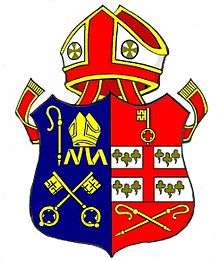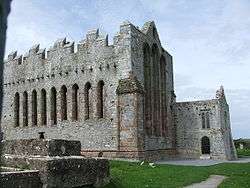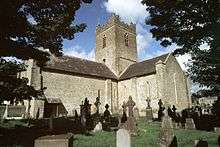Diocese of Limerick and Killaloe
| United Dioceses of Limerick, Ardfert, Aghadoe, Killaloe, Kilfenora, Clonfert, Kilmacduagh and Emly | |
|---|---|
 Coat of arms | |
| Location | |
| Ecclesiastical province | Dublin and Cashel |
| Information | |
| Cathedral |
St Mary's Cathedral, Limerick, Killaloe Cathedral, Clonfert Cathedral |
| Current leadership | |
| Bishop | Kenneth Kearon, Bishop of Limerick and Killaloe |
| Website | |
| limerick.anglican.org | |
The Diocese of Limerick and Killaloe (Full title: The United Dioceses of Limerick, Ardfert, Aghadoe, Killaloe, Kilfenora, Clonfert, Kilmacduagh and Emly) is a diocese of the Church of Ireland that is located in mid-western Ireland. The diocese was formed by a merger of neighbouring dioceses in 1976. It is in the ecclesiastical province of Dublin. It is one of the twelve Church of Ireland dioceses that cover the whole of Ireland. The diocese covers all of counties Limerick, Kerry and Clare, plus parts of counties Galway, Cork and Tipperary.
The current bishop is Kenneth Kearon, who was to be consecrated in January 2015.[1] The previous bishop was Trevor Williams who was elected on 6 May 2008[2] and consecrated at Christ Church Cathedral, Dublin on 11 July 2008.[3]
Overview and history

When the Church of England and the Roman Catholic Church broke communion, it was established by the state as the established church. Later, by decree of the Irish Parliament, the Church of Ireland became the independent State Church of the Kingdom of Ireland. It assumed possession of most Church property (and so retained a great repository of religious architecture and other items, though some were later destroyed). The substantial majority of the population remained faithful to Roman Catholicism, despite the political and economic advantages of membership in the state church. The English-speaking minority mostly adhered to the Church of Ireland or to Presbyterianism. In 1833, the two provinces of Dublin and Cashel were merged. Over the centuries, a number of dioceses were merged (see below), in view of declining membership. It is for this reason that the united diocese has three cathedrals.
Predecessor dioceses
The present united diocese dates from 1976, the end result of a number of mergers of sees beginning in the seventeenth century:[4]
| Ancient dioceses | Unions before 1976 | 1976 | |
|---|---|---|---|
| Diocese of Ardfert & Aghadoe | 1661: Diocese of Limerick, Ardfert and Aghadoe | Diocese of Limerick & Killaloe | |
| Diocese of Limerick | |||
| Diocese of Clonfert | 1602: Diocese of Clonfert & Kilmacduagh | 1834: Diocese of Killaloe & Clonfert | |
| Diocese of Kilmacduagh | |||
| Diocese of Kilfenora | 1752: Diocese of Killaloe & Kilfenora | ||
| Diocese of Killaloe | |||
| Diocese of Emly | United to Cashel from 1569-1976 | ||
Cathedrals


- St Mary's Cathedral, Limerick,[5]
- St Flannan's Cathedral, Killaloe,[6]
- St Brendan's Cathedral, Clonfert.[7]
Five others are in ruins or no longer exist:
- St Brendan's Cathedral, Ardfert was destroyed by fire in 1641
- St Alibeus' Cathedral, Emly was demolished in 1877.[7]
- Kilmacduagh cathedral, which is partly in ruins
- Aghadoe Cathedral, which is partly in ruins
- Kilfenora Cathedral, which is partly in ruins, dates from the 12th century.
Parish Groups
The diocese is divided into a number of parish groups.[8]
- Adare Group: St Nicholas', Adare • Croom • St Andrew's, Kilfinane • St Peter & St Paul's, Kilmallock • St Beacon's, Kilpeacon • Knockaney.
- Aughrim Group: St Catherine's, Ahascragh • Ardrahan • Holy Trinity, Aughrim • St Matthew's, Clontuskert • St John the Evangelist's, Creagh • Woodlawn, Kilconell.
- Birr Group: St Brendan's, Birr • Dorrha • Lockeen • St Ruadhan's, Lorrha.
- Clonfert (Cathedral) Group: St Brendan's Cathedral, Clonfert • St John the Baptist's, Donanaughta • Christ Church's, Lickmolassy • St Paul's, Rynagh.
- Cloughjordan Group: Ballingarry • Borrisnafarney • Borrisokane • St Kieran's, Cloughjordan.
- Drumcliffe (Ennis) Group: St Columba, Drumcliffe • Kilfarboy • St Fachan's, Kilfenora • St James', Kilfieragh • Kilnasoolagh • Christ Church's, Shannon.
- Kenmare Group: St Michael & All Angels', Dromod • St Patrick's, Kenmare • Church of the Transfiguration, Kilcrohane • St John the Baptist's, Valentia.
- Kilcolman (Milltown) Group: St John's, Glenbeigh • Kilcolman • St Michael's, Killorglin • St Carthage's, Kiltallagh • Knockane.
- Killaloe (Cathedral) Group: Inniscaltra • St Flannan's Cathedral, Killaloe[9] • St Senan's, Kiltinanlea • All Saints', Stradbally • St. Cronan's Church, Tuamgraney.
- Killarney Group: St Mary, Killarney • Holy Trinity, Muckross.
- Limerick (Cathedral) Group: St Mary's Cathedral, Limerick • Abington • St Michael's, Limerick.
- Nenagh Group: Killodiernan • St Mary's, Nenagh • Templederry.
- Rathkeale Group: St Mary's, Askeaton • Kilcornan • Kilnaughtin • Holy Trinity, Rathkeale.
- Roscrea Group: St Burchin's, Bourney • Christ Church's, Corbally • St Molua, Kyle • St Cronan's, Roscrea.
- Shinrone Group:[10] Aghancon • Dunkerrin • St Finnian's, Kinnitty • St Mary's, Shinrone.
- Tralee Group: Ballymacelligott • Ballyseedy • St James's, Dingle • Kilgobbin, Camp • Killiney, Castlegregory • St John's, Tralee.
- Plus the University of Limerick.
List of bishops
|
|
See also
- Dean of Limerick and Ardfert
- Dean of Killaloe and Clonfert
- List of Anglican dioceses in the United Kingdom and Ireland
- Roman Catholic Diocese of Limerick
- Roman Catholic Diocese of Kerry (formerly Ardfert and Aghadoe)
- Roman Catholic Diocese of Killaloe
- Roman Catholic Diocese of Galway, Kilmacduagh and Kilfenora
- Roman Catholic Diocese of Clonfert
- Roman Catholic Archdiocese of Cashel and Emly
References
- ↑ "New Bishop Elected". The United Dioceses of Limerick and Killaloe. Retrieved 13 December 2014.
- ↑ Canon Trevor Williams Elected Bishop of Limerick and Killaloe. Retrieved on 9 January 2009.
- ↑ Consecration of the Rt Revd Trevor Williams as Bishop of Limerick. Retrieved on 9 January 2009.
- ↑ Galloway, Peter (1992). The Cathedrals of Ireland. Belfast: Institute of Irish Studies, Queen's University Belfast. pp. 10, 48,97,142. ISBN 0853894523.
- ↑ St Mary's Cathedral, Limerick. Retrieved on 9 January 2009.
- ↑ St Flannan's Cathedral, Killaloe. Retrieved on 9 January 2009.
- 1 2 The Cathedral Churches of Limerick and Killaloe. Retrieved on 9 January 2009.
- ↑ Parish Information. Diocese of Limerick and Killaloe website. Retrieved on 6 October 2009.
- ↑ St Flannan's Cathedral, Killaloe. Retrieved on 7 September 2009.
- ↑ Shinrone Group of Parishes. Retrieved on 7 September 2009.

